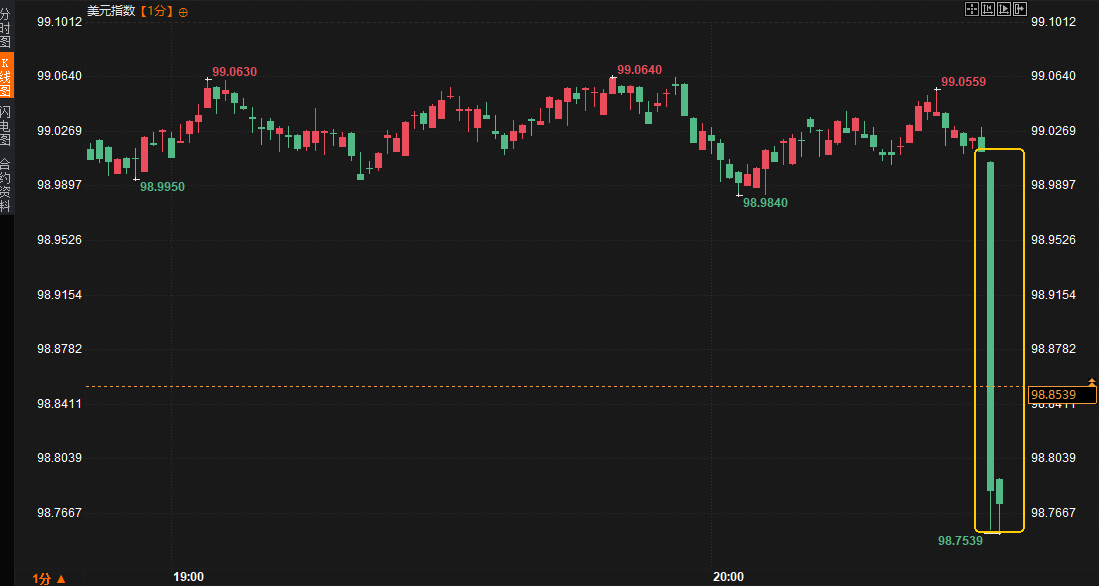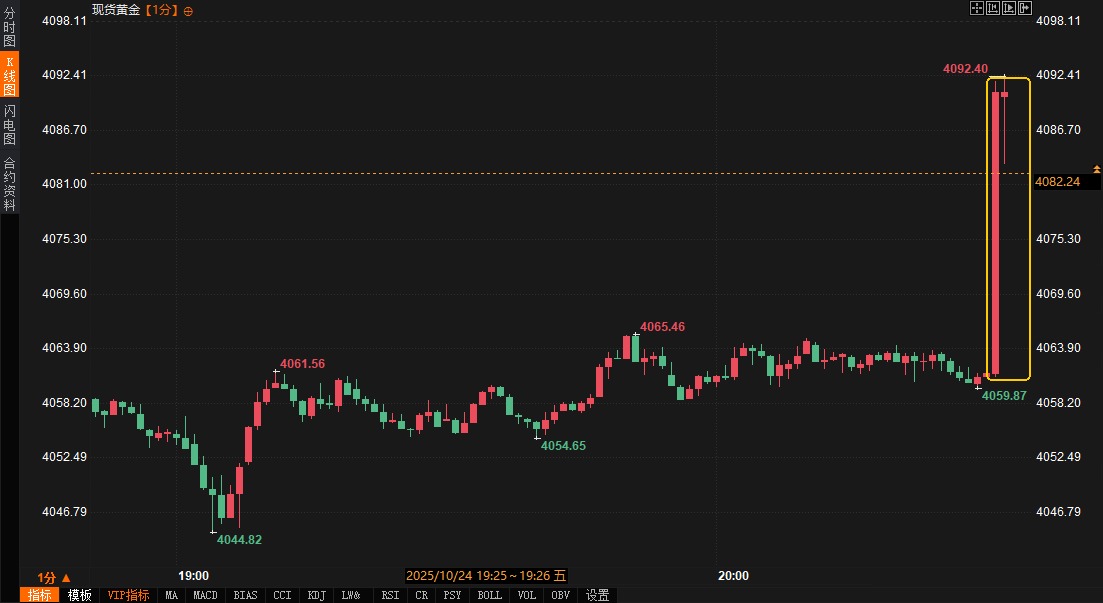CPI detonated the first bomb in the data vacuum period: the US dollar plunged and gold rose by $30, and the next non-farm payrolls may be postponed again!
2025-10-24 21:02:57

Real-time market reverberation: The surprise below expectations ignites the bulls
Upon the release of the data, the market rebounded in relief. Spot gold briefly rose about $30, reaching a high of $4,092.65 per ounce. The US dollar index plunged nearly 30 points, hitting a low of 98.7190. The CBOE Volatility Index (VIX) fell 0.71 points to 16.59, hitting a two-week low. Stock futures subsequently jumped, and the US Treasury yield curve steepened. The 2-year yield fell 3 basis points to 3.453%, while the 10-year yield edged down to 3.985%. The 2/10 spread widened to 52 basis points from 50.8 basis points on Thursday. This represented an orderly release of the uncertainty that had accumulated during the shutdown. While inflation remained stubbornly above the 2% target, it did not intensify as expected. Energy price fluctuations (gasoline prices rose 4.1% month-over-month, but electricity prices fell 0.5% and natural gas prices fell 1.2%) were the primary driver, while a slowdown in service and housing costs provided some respite. Compared with the sluggish employment growth of only 22,000 in August, this CPI, although not negative, has been magnified as "relatively positive" in the data vacuum, driving a short-term recovery in risky assets.


Sentiment before and after the release was starkly contrasting. Before the data was released, traders were betting on the 3.1% threshold, fearing a rebound in inflation might force the Fed to tighten its policy. One veteran forex observer bluntly stated, "If CPI exceeds 3.1%, the dream of multiple rate cuts this year will be shattered, and the US dollar could resume its upward trend." Retail investors were also shrouded in caution, with one intraday swing trader commenting, "Data delays have become the norm amid the shutdown, and hawkish expectations are holding bulls back." However, the tide turned sharply after the data was released. Stock futures surged, the VIX plummeted, and the weaker-than-expected CPI figure dominated the market. Institutional analysts emphasized that the reading was "0.1% below expectations, reinforcing the central bank's motivation to prioritize employment." Another macro strategist observed, "With the core rate at just 0.2% month-over-month, signs of cooling in services inflation are emerging, making a 25 basis point rate cut by the Fed next week virtually certain."
Retail investors' reactions were more direct and vivid. One trader exclaimed, "The CPI surprise was below expectations, and gold prices rose by $30!" Now the FOMC can ease its monetary policy with confidence. The 3.0% reading opens a path for a bullish trend, and the VIX's plunge was a signal. Compared to the week before the release, the focus was largely on concerns about rising import prices for goods (such as furniture) due to tariff rhetoric. Retail investors argued that "inflation may rebound due to external friction, and the Fed should be wary of premature rate cuts." Now, these voices have faded, replaced by optimistic interpretations of "cooling pressures." With inflation higher than in August but lower than expected, this balance plays into the Fed's favor, preventing inflation from spiraling out of control despite weak employment. Overall, the market has shifted from hawkish caution to dovish easing in the future. Institutional investors emphasize the data's support for the policy anchor, while retail investors focus more on the linkage with emerging assets, with a gold rebound becoming the consensus focus.
This shift in sentiment is not isolated; it is embedded in a broader macroeconomic context. While the September CPI reflects continued pressure on consumer prices, the unexpected slowdown in core indicators has alleviated some concerns about a "price spiral." Economists from prominent institutions commented, "Inflation is gradually rising but not out of control. Combined with the sluggish summer hiring, Fed Chairman Powell's 'risk-free path' is becoming a reality." A former Wall Street trader echoed this sentiment: "Amidst the black hole of employment data, this CPI serves as a beacon, guiding next week's meeting to prioritize the labor market rather than aggressively resisting inflation." Historically, during a similar 35-day shutdown in 2019, CPI delays amplified volatility. However, this 3.0% reading is closer to neutral than then, avoiding an extreme hawkish-to-dovish shift. Market sentiment has thus shifted from pre-market anxiety—the Fed's potential for cautious wait-and-see action in the data vacuum—to a consensus on "limited easing," with initial signs of accumulation of short positions in the US dollar.
Outlook: The Fed's path in a data vacuum: cautious rate cuts become the main theme
Next week's Federal Open Market Committee meeting is expected to result in a 25 basis point rate cut, lowering the federal funds rate range to 3.75%-4%, as expected. However, the subsequent pace of the federal funds rate this year remains uncertain. While the CPI fell short of expectations, it did not reverse the trend of inflation remaining above the 2% target. Coupled with the extended shutdown (markets are betting on a 41-day period, until early November), the October non-farm payroll report may not be released on time, further clouding the employment picture. Institutional views are becoming more conservative: one columnist warned, "The data gap may force the Fed to maintain a 'curious balance'—slowing hiring and tightening labor supply, with borrowing costs hovering in the 4% range, testing policy flexibility." Retail investors also seized on this concern, stating, "A 41-day shutdown is a repeat of 2019. The Fed may be inclined to experiment in its blind flight, reducing the probability of a 50 basis point rate cut by the end of the year."
In the long term, this CPI figure will provide a floor for risk assets, but external factors are driving uncertainty. The aftermath of tariff rhetoric may continue to push up some import costs. While AI capital expenditures contributed 1.1% growth in the first half of the year, this hasn't been enough to mask consumer weakness. If the shutdown extends into early November as expected, the employment black hole will exacerbate the conflict between the Federal Reserve's dual mandates: stable inflation versus maximum employment. The market may enter a period of sideways trading after a short-term rebound, with the US dollar index holding above 90 and gold hovering above 4,000. Trader consensus is emerging: the Fed will anchor its path with cautious rate cuts, avoiding premature stimulus that rekindles price pressures. The market needs to await subtle signals from next week's statement to discern the depth of easing measures this year.
- Risk Warning and Disclaimer
- The market involves risk, and trading may not be suitable for all investors. This article is for reference only and does not constitute personal investment advice, nor does it take into account certain users’ specific investment objectives, financial situation, or other needs. Any investment decisions made based on this information are at your own risk.





















